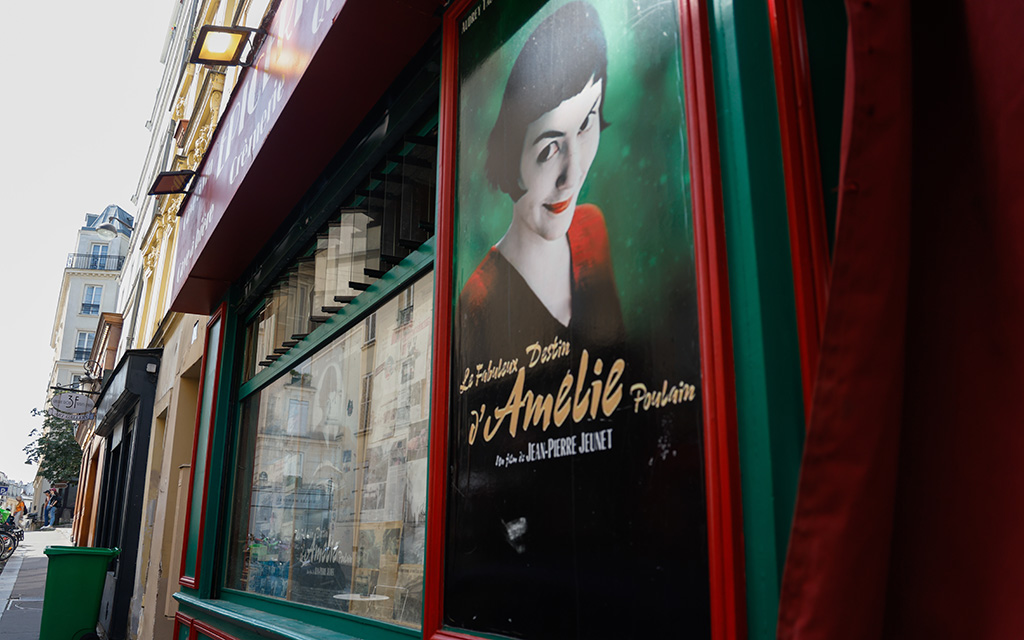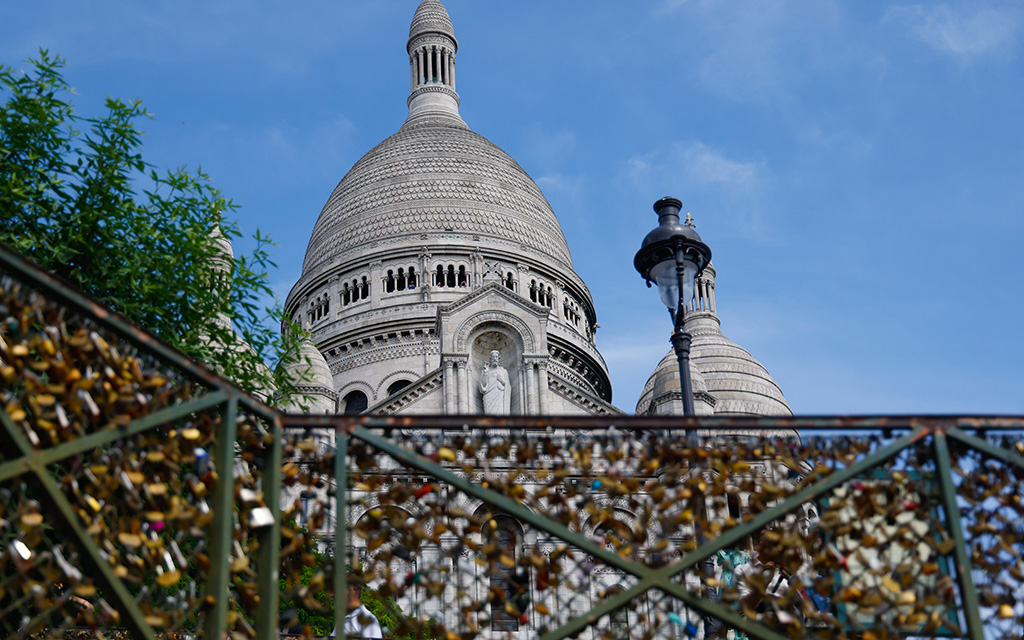
An Amélie poster is displayed on the side of Au Marche De La Butte, a famous landmark from the movie, in Paris. The city is popular with filmakers because of its beauty. (Photo by Sydney Lovan/Special for Cronkite News)

Love locks – small padlocks that couples attach to a structure as a symbol of their love and commitment – are displayed on the fences in front of La Sacre Coeur, a tourist hotspot, in Montmartre that’s also been featured in films. (Photo by Sydney Lovan/Cronkite News)
PARIS – Hollywood may be the cinematic capital of the world, but few cities are featured more in film than the City Of Light. From American favorite such as “The Da Vinci Code,” “Midnight in Paris,” “Mission Impossible: Fallout” and “Taken” to French hits like “Amélie,” Paris has provided the backdrop for some of cinema’s best projects.
Paris’ flexibility as a film-making city has no bounds. The city has countless iconic scenes from movies. With its rich film history, more and more directors requested to shoot in Paris following the COVID-19 shutdown.
“The thing with Paris is its beauty,” said Juliette Dubois, founder and director of Ciné-Balade. “You can project what you want to project. This is part of the magic, and also there is all the history, all the heart which has inspired the movie makers.”
It all started in Paris, Dubois said. In 1895, French siblings Louis and Auguste Lumiere shot and created the first commercial movie in film history and were the first to sell tickets to see a movie. Since then, Paris has been the city for many filmmaking milestones. Director and actor George Méliès pioneered fantasy and science fiction in film. Alice Guy-Blache became the first woman to direct a movie and was one of the first women to write a fictional film.
Now, Paris has seen countless hits filmed in its streets. One of the most famous is “Amélie,” which came out in 2001. While using famous sites like the Sacre Coeur, the movie also showed beautiful shots of mundane scenes, like the subway and street cafes.
“Paris is very different because of the different neighborhoods, so you can rebuild something in a new neighborhood and leave something in one,” said French actress Claude Peron, who played Eva in Amélie. “You can live another part of your life (there), so it’s quite interesting.”
Movies like “John Wick 4” (2023), “Monte Carlo” (2011), the Netflix series “Emily in Paris” (2020) and the popular Pixar movie “Ratatouille” (2007) have shown Paris and how versatile of a set it can be. Scenes have shown popular places incuding stairs at Rui Foyatier as well as the streets surrounding the area.
However, with fleet of cameras flocking towards Paris to film, organizers are struggling to meet the requests that directors have when trying to make movies in the city.”
Part of the issue is that most request the same neighborhoods and famous sites. Places like Sacre Coeur, the Eiffel Tower and neighborhoods like the 7th and 8th districts are highly sought after by directors due to previous successes shot around the Montmartre area, like “Amélie.”
“(Directors) usually have several sets and sceneries that they’re used to, so they always want the same ones,” Pecas said. “This is why there are these traffic jams in these areas because of all the vehicles. We try to encourage them to go shoot in the 13th and 14th districts, which are not areas where they naturally go.”

Claude Perron, right, the actress featured in “Améile,” talks with journalists on a tour around famous movie spots in Montmartre. (Photo by Sydney Lovan/Special for Cronkite News)
There aren’t any movie shoots planned while the Summer Olympics are in town, but after the Games end, a long line of directors want to shoot in Paris. So, if everyone wants to shoot in the same places, it causes those neighborhoods to shut down for longer, even though there are great places to shoot all over the city.
Film crews cause plenty of ruckus regardless of where they shoot, however. One of the main issues is that sets created in the streets of Paris are distruptive to locals. Typically, most large shoots in the city are organized in the summer months, but this year, the Olympics caused more shoots to come in early 2024, which also caused a heavy-loaded end to the year. This disrupted the lives of locals during filming.
“Paris shouldn’t be a studio for us,” Pecas said. “We welcome lots of film shoots. We make sure they take place in the best conditions, but you shouldn’t bother the citizens more than absolutely necessary.”
Pecas has encouraged directors to film only in Paris when necessary and to use studios for what can be shot there, along with asking them to try different areas.
Despite the potential for local disruption, Paris Film is adamant about keeping the city accessible to filmmakers. Famous places are easily accessible for filming without any significant hurdles; the process is the same as shooting in the street as long as Pecas and Co. can anticipate when and how to organize it.
Paris Film also does not monetize allowing movies to be made in Paris, outside of paying for parking in certain areas and any fees associated with moving equipment and reserving areas.
“(Directors) like Paris, and they’re asking for Paris, (which) is a good thing,” director of Paris Film Stéphane Pecas said. “The idea is to be able to continue to make Paris accessible, but this requires (directors) to adapt to constraints for production.”
Filming in Paris will only continue to grow, especially now that streaming has increased the amount of content providers want to create. “Emily in Paris” just shot its fourth season in the city, with more shows and movies in line behind it.
Organizing may be challenging, but parts of Paris’s economy rely on the movie business. The city made $21 billion in tourism in 2022, which is still less than pre-COVID numbers.
“It’s a big economy,” Dubois said. You have French technicians and directors, so we want to promote that economy. It’s good for tourism.”
In a city where eye-catching scenes are found on every street and every alley, movies are one of the best ways to advertise Paris and France’s incredible culture. There are challenges to it, but Paris has been more than willing to share its unmatched elegance.
“It’s part of our heritage, our identity,” Dubois said. “Paris is the most filmed city in the world, ahead of New York, but it’s also a city of viewers. There are many screens, movies, cinemas and movie theaters, so we have become aware. It’s part of our culture.”